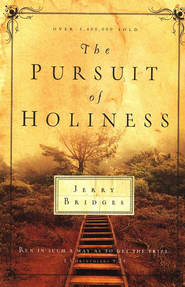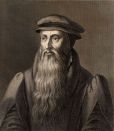 In 1801, Barton Warren Stone, pastor of Cane Ridge Presbyterian Church, began circulating the word that the Cane Ridge sacramental communion was to be “one of the greatest meetings of its kind ever known.” As the news spread, congregations and pastors packed up for journeys from not only Central Kentucky but also southern Ohio and northern Tennessee.
In 1801, Barton Warren Stone, pastor of Cane Ridge Presbyterian Church, began circulating the word that the Cane Ridge sacramental communion was to be “one of the greatest meetings of its kind ever known.” As the news spread, congregations and pastors packed up for journeys from not only Central Kentucky but also southern Ohio and northern Tennessee.
The Cane Ridge Presbyterian Church sat on the slopes of a large hill covered with bamboo (hence the name) and some trees. It was a rustic meeting-house which could hold as many as 500 people (standing). Recently, the congregation had also erected a large tent to accommodate more people.
Scottish and Ulster Presbyterians had held these types of regional communion services back in their old countries for centuries. In times of persecution, they had thrived in rural settings. Sacramental communion services in the months preceding the early August gathering at Cane Ridge had attracted thousands of people.
Pastor Stone had previously shared with the Cane Ridge Congregation his own experiences of what he had seen take place at the previous meetings elsewhere. He told them of many people falling down, like rows of soldiers shot down by volley fire. Many lay quiet for hours and then spoke declaring the wonderful works of God.” As Stone spoke to his congregation they were affected with a deep solemnity and many wept. After the great meeting yet to come, Pastor Stone would say, “A particular description of this meeting would fill a large volume, and then the half would not be told.”
When August 6 arrived, no one had anticipated what was coming. The atmosphere was electric. As travelers began to arrive, there was a downpour of rain. Cane Ridge families opened their homes to the travelers. The visitors, however, grew from hundreds into thousands. Many had to find lodging miles away, but many had come ready to camp. The rain continued into the evening which may have held back some of the crowds. Yet, the meetinghouse was packed. A sermon was delivered by Matthew Houston and afterwards some lingered all night in prayer.
On Saturday morning, the services were quiet. By afternoon, however, the preaching from both the meetinghouse and the tent was continuous. Emotions increased and the camp was erupting in noise. There was shouting and crying, and then some began falling. Others experienced weakened knees or a light head. According to testimonies, those who fell did so out of agony and fear. They were so scared that they couldn’t move. Some lay on the ground for two or three days praying until they received assurance of salvation.
There were preachers from several denominations who arrived and set up pulpits in tree stands. Often, as many as seven preachers were addressing different crowds throughout the woods. According to Iain Murray there were eighteen Presbyterian ministers. There were also many Baptist and Methodist preachers who took part in the services which continued for a week. The tents that had been set up were estimated to shelter between 10,000 and 21,000 people.
Some people supposed there were nearly twenty-five thousand men, women, and children collected together around Cane Ridge. The roar of noise was described like that of Niagara. Some of the people were singing, others praying, some crying for mercy, while others were shouting. One witness looking over these scenes said he felt a peculiarly strange sensation, such as he had never felt before. His heart was beating wildly, his knees trembled, his lip quivered, and he felt he would fall to the ground. Later, this same witness reported seeing at least five hundred people swept down in a moment. It was as if a battery of a thousand guns had been opened upon them. According to another witness, the meeting appeared as if twenty thousand persons were being tossed to and fro, like waves of the sea in a storm.
In spite of the sincere and serious Christian attitude of the encampment, there was all manner of wickedness taking place outside the camp. Men, in a drunken fever, committed indecent acts; and others, would ride their horses at full gallop among the people. One of the leaders of these ruffians rode a large white horse into a circle of praying worshippers. At the same time, he was shouting obscene curses at those gathered. Then, suddenly, he appeared to be struck from his horse. As he lay on the ground, his limbs were rigid, no pulse could be found, and the breath was knocked out of him. Several of his gang came to see him, but after looking at him they fell like men slain in battle. He lay there for thirty hours. At last he exhibited signs of life, but appeared to be in agony. When he gained use of his feet, his groans were converted into loud and joyous shouts of praise.
Night came and the camp fires cast large shadows against the trees. There were candles, lamps, and torches throughout the camp as hundreds moved about. Preachers continued to shout sermons from the tent as people sang hymns.
On Sunday morning, many had been up most of the night. Yet, the Communion took place as scheduled in the meetinghouse. The minister of a nearby congregation preached the traditional sermon outside and those with Communion tokens went inside for the sacrament. The tables could accommodate about 100 at a time.
Since the Methodists were excluded from the meetinghouse and tent, William Burke, one of Methodism’s most esteemed preachers, began Methodist services outside and gathered a huge audience. There ran concurrently four centers of activity around the camp and dozens of informal prayer groups at various camp sites. Crying for mercy, believers praying, fainting, and raptures of joy continued. The people sang, shouted, clapped their hands, and hugged one another. As the night came, some stayed up all night continuing in more prayer, exhortation, and singing.
Food and supplies were running short by Monday and many had to leave. In spite of this, there came many new arrivals and Cane Ridge remained densely populated. The meeting continued for four more days before ending on Thursday. These extraordinary services began at sun up and continued well into the night. While some fell to their faces as the weight of their sins struck them cold, many sang and danced as they felt the presence of God in their midst and experienced a touch from Jesus Christ.
Bibliography
Erdmann’s Handbook to Christianity in America. Editor Mark Noll. Grand Rapids, Michigan: William B. Eerdmans, 1983.
Johnson, Charles A. The Frontier Camp Meeting: Religion’s Harvest Time, Dallas: Southern Methodist University Press, 1985.
LaTourette, Kenneth Scott, A History of the Expansion of Christianity, IV (Grand Rapids: Zondervan, 1970), p. 192.
Murray, Iain H. Revival & Revivalism: The Making and Marring of American Evangelicalism 1750-1858, Carlisle, PA: The Banner of Truth Trust, 1994.
Filed under: Bible, Christianity, Faith, Grace, History, Holiness, Holy Spirit, Jesus Christ, Prayer, Preaching | Tagged: Banner of Truth Trust, Cane Ridge, Cane Ridge Kentucky, Christianity, Iain Murray, Methodism, Methodist, Southern Methodist University Press | Comments Off on The 1801 Revival At Cane Ridge












































































